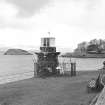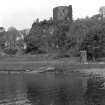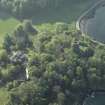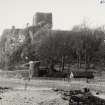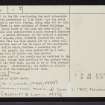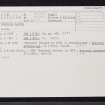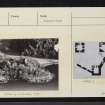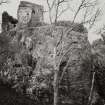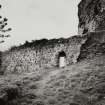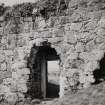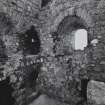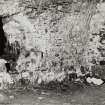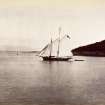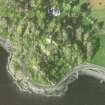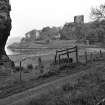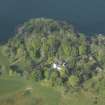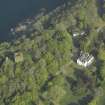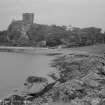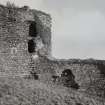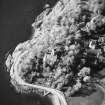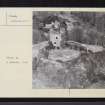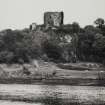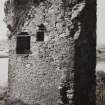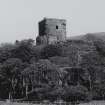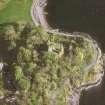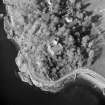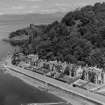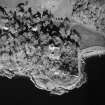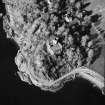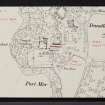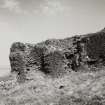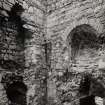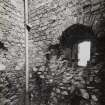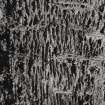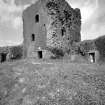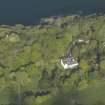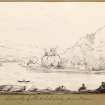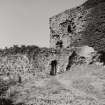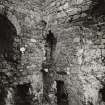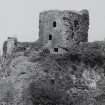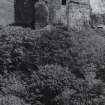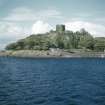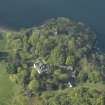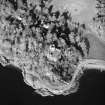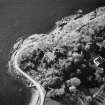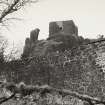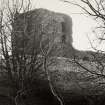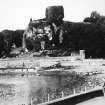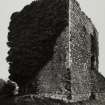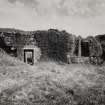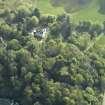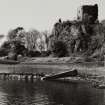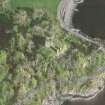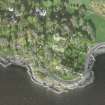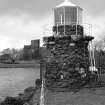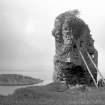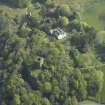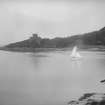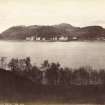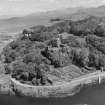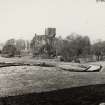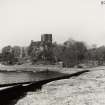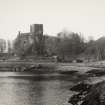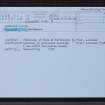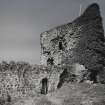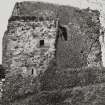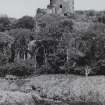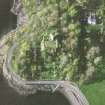Scheduled Maintenance
Please be advised that this website will undergo scheduled maintenance on the following dates: •
Tuesday 3rd December 11:00-15:00
During these times, some services may be temporarily unavailable. We apologise for any inconvenience this may cause.
Dunollie Castle
Castle (Medieval), Earthwork(S) (Period Unassigned)
Site Name Dunollie Castle
Classification Castle (Medieval), Earthwork(S) (Period Unassigned)
Alternative Name(s) Dun Ollaigh; Oban Bay; Dunolly
Canmore ID 23027
Site Number NM83SE 11
NGR NM 85215 31484
Datum OSGB36 - NGR
Permalink http://canmore.org.uk/site/23027
- Council Argyll And Bute
- Parish Kilmore And Kilbride
- Former Region Strathclyde
- Former District Argyll And Bute
- Former County Argyll
NM83SE 11 85215 31484
(NM 8522 3148) Castle (NR)
OS 1:10,000 map, (1976)
The ruins of Dunollie Castle occupy the summit of a rock promontory towards the north end of Oban Bay. The remains comprise a tower house with an associated courtyard, together with fragmentary traces of an outer enclosure embracing the remaining area of the summit. The tower is set diagonally in the NE corner of the courtyard, the most vulnerable part of the castle, the natural line of approach being from the NE. It has four main storeys, each a single apartment, the lowest being a barrel-vaulted cellar with a doorway in the west wall. The entire wall-head is now ivy-covered but traces of a parapet walk can still be seen. The courtyard, 24.4m square, was formerly completely enclosed by a curtain wall, now reduced to its lowest courses except on the north and east where it still has an average height of 4.6m. The wall in the NE, overlooking the most vulnerable sides of the promomtory is 2.3m thick, but the south and west walls are less strong, being only 0.6 to 1.5m thick. There is some evidence of former buildings along the inner faces of the east and west walls. The east curtain also incorporates a much restored entrance gateway. A second entrance, in the form of a postern doorway of zig-zag plan, formerly pierced the north curtain, but this has been sealed off by a cross wall. About 9metres east of the SE angle of the courtyard, a natural defile which provides a possible way of ascent to the summit, has been sealed off by a well- constructed wall of rubble and lime mortar.
The greater part of the castle may be ascribed to the 15th century, though some portions of the curtain wall, notably on the west side, appear to be of 16th century or later date. Historically, the castle is closely associated with the MacDougalls of Lorn.
D MacGibbon and T Ross 1887-92; RCAHMS 1975, visited July 1968.
As described
Surveyed at 1:2500 scale.
Visited by OS (R D) 31 August 1971.
Limited excavations were carried out on earthworks N and E of Dunollie Castle from August to September 1978, as part of a programme of research on Early Historic fortifications in Scotland, undertaken by the Department of Archaeology, University of Glasgow. Four main structural phases were detected. The first two may be dated by stratified finds to the late 7th-8th centuries AD. The third appears to be a defensive work of the 13th century, while the fourth represents relatively modern landscaping and tidying of the derelict castle.
L Alcock 1978
Publication Account (1985)
This tower-house occupies a conspicuous position on the summit of a rocky ridge to the north of Obani the lands of Dunollie have one of the longest recorded histories in the west, for in 698 a fdrtress here was captured and destroyed by the Irish enemies of the kings of Dalriada, but the date of the building of the castle as the seat of the MacDougalls has been a matter of debate. It is, however, most likely that it takes its place within the series of broadly 15th century towers, with the courtyard wall of similar and later date. The tower has four main storeys, with a cellar beneath two simple rooms reached by stairs in the south angle. An unusual feature of the cellar is the impression left by the wicker-work used to support the roof during construction, a technique more common in Ireland than in Scotland. A stair leads from the entrance passage to the first floor, a similar right-angled stair from the first- to the second-floor hall, and a turnpike stair from there to the upper levels.
In 1715 the chief of the clan MacDougall was forfeited, but the lands were later restored to his son and the more modem residence, Dunollie House (NM 853315), was built in 1746.
Information from ‘Exploring Scotland’s Heritage: Argyll and the Western Isles’, (1985).
Note (5 January 2015 - 19 September 2016)
Dunollie crowns a precipitous stack overlooking the N exit of the Sound of Kerrera and the passage into the sheltered waters of Oban Bay. Crowned by a ruined tower-house and its courtyard, the references by annalists for the years AD 686, 698, 701, 714 and 734 also indicate this was the site of an early medieval fortification, the existence of which was confirmed by excavations directed by Leslie Alcock on earthworks first shown but not annotated on the 1st edition of the OS 25-inch map (Argyllshire 1874, sheet 98.3). In his interpretation, the stone castle masks a citadel, while a bank on the leading edge of a terrace some 15m to the N incorporates a massive stone rampart up to 5m thick enclosing an upper court; overlying a metalworkers hearth associated with artefacts and radiocarbon dates spanning from the late 5th to the late 9th centuries AD, its collapsed ruin was overlain by deposits dated between the mid 9th and mid 11th centuries AD. Sometime later, another rampart was built on this line, though this may well belong to the 13th century or later. A similar undated sequence of construction was recovered from a terrace lower down on the E flank of the stack. While the presence of an early medieval fortification here is not in doubt, its form and extent are unknown. The medieval castle occupies an area of about 0.08ha on the presumed site of the citadel on the summit of the stack, while the position of the rampart to the N might increase this to 0.17ha, and the lower rampart on the E to perhaps as much as 0.24ha overall.
Information from An Atlas of Hillforts of Great Britain and Ireland – 19 September 2016. Atlas of Hillforts SC2661
Standing Building Recording (March 2016 - July 2016)
NM 85240 31460 Three phases of work were undertaken at Dunollie Castle between March and July 2016. These involved the drawing of the SW and SE elevations of the tower stonework, a watching brief undertaken on removal of topsoil over the wall core at the SW corner of the tower, and the re-excavation of a previously excavated trench in the castle courtyard. The excavation revealed several built features that occupied the courtyard, these included: a wall and doorway of a building occupying the NW corner of the courtyard along with an associated external surface and drain.
The trench also revealed a wall of what is likely a revetment to a raised area or platform around the castle tower. The finds from the trench suggest the features were last in use in the 18th century prior to their demolition or abandonment. The outlines of other buildings within the courtyard were also recorded, along with a previously unrecorded length of
walling associated with the early historic enclosure to the S of the medieval castle.
Archive: Auchindrain Trust (intended). Report: HES, NRHE and WoSAS
Funder: Dunollie Projects Ltd
Roddy Regan – Kilmartin Museum
(Source: DES, Volume 17)
Excavation (July 2017)
NM 85240 31460 A second phase of excavation work was carried out, July 2017, in the castle courtyard at Dunollie, following initial work undertaken in 2016. This involved excavation of in situ deposits around the existing trench edges and over some of the built features exposed last year. Finds included food waste (mainly bone and shell) along with pottery (tin glazed
earthenware and Staffordshire slipware) and glass. The excavated deposits confirmed the picture of habitation of courtyard buildings dating from the late 17th to early 18th century prior to their demolition or abandonment.
Archive: Kilmartin Museum. Report: NRHE and WoSAS SMR
Funder: Dunollie Projects Ltd
Roddy Regan – Kilmartin Museum
(Source: DES, Volume 18)
Archaeological Evaluation (10 June 2019)
NM 85215 31484 A preliminary non-intrusive survey of the ground and first-floor masonry fabric of the tower at Dunollie Castle (Canmore ID: 23027), was undertaken, on 10 June 2019. The masonry has been raised in formal courses up to 0.4m high and is composed of lime-bonded undressed rubble of mixed geologies, framed with sandstone dressings displaying visible tool marks. The masonry has been coated with lime mortar both internally and externally. Internally, constructional mortar visibility is extensive and includes continuous core-bed and coating materials with significant evidence for wicker formwork on the intrados of the basement vault. In general, the constructional mortar displays high concentrations of entrapped limekiln relicts and can be confidently characterised in situ as a wood-fired meta-limestone-lime tempered with foreshore aggregates. The relict limekiln fuel component exposed on mortar surfaces presents evidence for a mixture of tree taxonomies, including both ring-porous and probable diffuse porous wood-charcoal fragments.
Archive: NRHE (intended)
Funder: Historic Environment Scotland and University of Stirling
Mark Thacker - University of Stirling
(Source: DES Vol 20)






















































































